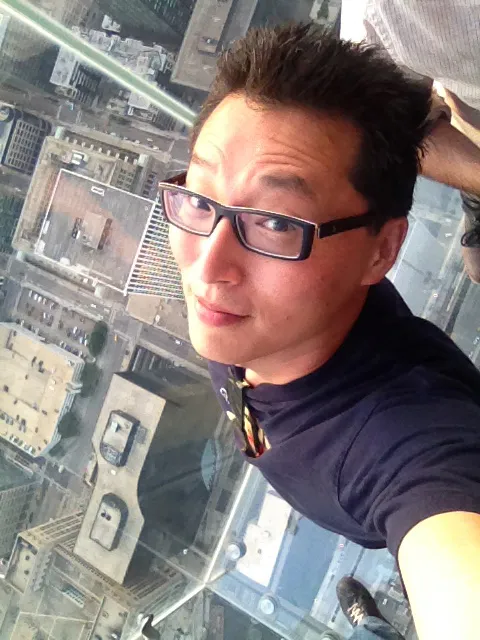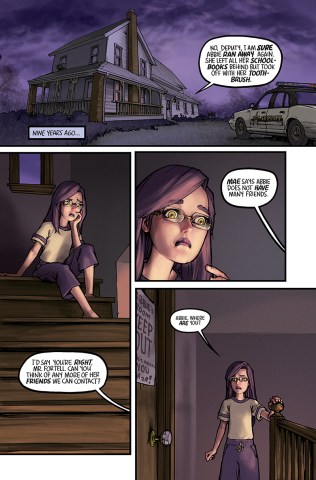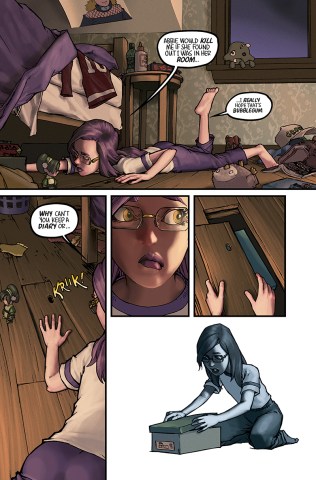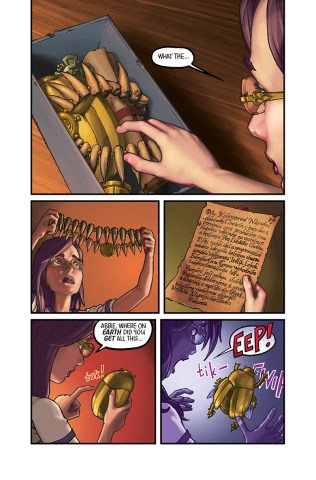In a comics community that’s increasingly hungry for nuanced female protagonists and female-centric stories, Dark Horse Comics is providing just what they’re craving with an awesome new title by Eisner Award-winning creator, Gene Ha.
The series is called Mae, and it tells the story of the Fortell Sisters: the titular Mae, and her frequently absent older sister, Abbie. Abbie ran away when Mae was eleven, leaving Mae alone to take care of her ailing father. Now that Mae’s in college, she discovers exactly where her sister disappeared to all those years ago, and it changes her life forever.
Gene Ha is both the writer and artist on Mae, and in an email interview he talked to me about the importance of female characters, all-ages comics, and how a new, young, diverse readership is forcing the industry to change the face of comics.
Teresa Jusino (TMS): Where did the idea for Mae come from? How did this story develop?
Gene Ha: My biggest inspiration was Kyle Baker’s Why I Hate Saturn. It’s a character study of two sisters. Anne is a drunk and disorderly columnist. Laura is squared away, but also believes she spent the last few years as the Queen of the Leather Astro-Girls of Saturn. They argue and mock each other, a lot. Baker’s book opened my eyes in so many ways. I loved Laura’s perhaps delusional back story. Saturn showed me that you don’t need fights and action scenes to have great character conflicts. They can even be friends and sisters. And I learned that you can write heroes that don’t look like standard comics protagonists or like yourself (Kyle Baker is African-American). If you’re willing to learn and ask questions you can discover just how different other folks’ lives are, and write about them honestly.
I began doodling two sisters, one a space girl and the other a mechanic. Over time they began changing. Abbie lost the helmet and began wearing a colonial era jacket. Mae switched from overalls and got her signature Tom Baker Doctor Who scarf. Once I figured out why they dressed that way I finally had the story that became Mae.
TMS: Abbie seems to be the kick-ass one, but the series is called Mae. What can we expect from Mae as a character as the story goes on?
Ha: This is the story of how Mae becomes her own hero. Her sister Abbie ran away when she was 11, and Mae soon had to care for her ailing father and manage the computer shop. She had to grow up fast.
Her sister’s return and father’s disappearance means Mae has lost her old life, but it’s also her first chance to define what she wants to do with her life. She can’t be a fighting machine like Abbie, but because Mae is brave and smart she can solve problems that Abbie can’t fix.
Cimrterén, the other world, is a mess in part because Abbie always wants to solve problems with her fists. Mae will become the greater hero because she doesn’t shoot first and ask questions later. Mae’s going to learn the limits of Abbie’s style of heroism, and that will help Mae figure out what kind of hero she wants to become.
TMS: This is a creator-owned book where you’re on both writing and art duty? Did you do colors, inks, and lettering as well? Do you feel a greater sense of freedom doing a book entirely yourself? Is there a part of you that misses the collaborative nature of working with another writer/artist/etc on a book? Why is this story one that you had to be completely involved with?
Ha: I love drawing the scripts of great writers! The problem is, I have a very distinct vision of who Mae and Abbie are and you can’t get great scripts from a writer if you limit them to someone else’s vision. I had to write this myself.
The setting and back story are very complex. Like HBO’s The Wire, every piece matters. The Fortell sisters have naturally purple hair and orange eyes. The first explorers of the other world were Czech and that affected how they governed the world and why they kept it secret. There’s a reason for everything. It’s a huge history and I can’t hand it off to another writer. My freedom would become their shackles.
I have given small parts of the world to other writers. There’s a short prequel story from Mae’s high school days written by Danny Busiek. As a modern young geek girl Danny understands that corner of my world far better than I do. It was exciting to learn about Mae’s history from Danny!
My Top 10 layout artist, Zander Cannon, is lettering and I had color assistance from Rose McClain. Other than that, the first 2 issues were all me. In the US comics industry we call the inked page the “finished” art, but my vision for the art isn’t just black and white. So I had to color the first story myself.
To keep the book on schedule, with Mae #3 I handed off coloring duties to Wes “Wesflo” Hartman. I’m happy I’ve established the look well enough so that I can hand it off to such a brilliant colorist.
TMS: Why Dark Horse? What was it about Mae and Dark Horse that made them a perfect fit?
Ha: I’ve never been loyal to companies, I’m only loyal to people. Their top management made sure I trusted them as individuals to give me my creative freedom. And they put it in writing too.
My editor Daniel Chabon is a great partner in my labors. He understands that I’m telling the story of Mae my way, but Daniel’s never afraid to point out possible problems that I’ve missed. You want everything fixed before the story hits print. You can’t fix it afterward!
TMS: This is an all-ages book, which I love. Recently, I spoke with the creators of Alabaster Shadows about doing all-ages comics and why they’re important, and they mentioned that the resurgence of all-ages comics is, in part, to do with the fact that indie publishers are having more of a Moment right now, allowing for more inclusivity and a wider variety of movements and styles. Why is creating an all-ages comic important to you, and why do you think all-ages or youth-focused titles like Lumberjanes, and even Ms Marvel, are succeeding right now?
Ha: For most of my career comics has been on the brink of disaster. Comic shops kept closing, sales shrank, and we marketed to the same aging shrinking readership. I’ve long argued that we need to welcome new readers if we’re going to survive. That’s why I do free con sketches for kids and support public library events.
The comics hobby is growing again, but I don’t credit me or indie publishers or established comic companies. Comics is growing because young readers are forming online communities and creating their own content. Fanfiction and fan art is where they train, and some of them create new work and support it. Nimona, XKCD and Homestuck have huge and passionate followings, but they would have disappeared without a trace as comic shop titles.
We’re also seeing new venues for selling print comics. Scholastic sells comics to young readers through school book fairs. They don’t depend on Diamond so we don’t see them on the “Top 300” charts, but books like Amulet and Smile are bigger than anything from Marvel, DC or Image.
The reason we’re seeing more diversity in gender, age and race in comics is because these young readers are more diverse. DC and Marvel are just a small bit of comicdom and they’ve decided to open the gates and grow, instead of gatekeeping and dying.
TMS: In addition to all-ages comics being more popular these days, the all-ages books seem to be gearing more female-friendly. Mae features primarily female characters, and they are all amazing – and casually geeky, which I adore! Was it a conscious choice to speak more directly to a young, primarily female audience? What do you think that young boys and men can get out of reading the stories of wonderful female heroes?
Ha: I want to write about Mae and Abbie because I think they’re interesting and fun. And I love letting geeky girls see that they can be the heroes of their own stories. The question becomes whether people beyond me and the geek girls will be interested.
I really wasn’t sure when I started, but every year it becomes clearer that readers are growing braver and more curious. Stories like Paper Girls and Lumberjanes and the movie Frozen are popular with girls and boys. Readers love a good story even if the hero doesn’t look like them.
And part of making a good story is looking for new things to say, and new ways of saying it. Two years late I just started reading G. Willow Wilson’s Ms Marvel. You can see a lot of Spider-Man in the story, a teenage dork who uses superpowers to expand her horizons and discover herself. But by using a very different hero Wilson has made the tale fresh. The expectations on young Kamala are different, so she has to find different solutions. She wants to be a good Muslim but she doesn’t blindly accept how others tell her to be devout. She sticks up for herself and makes her own interpretation. As a girl she faces pressures to be virginal and to be sexy, and she has to struggle to a spot where she’s neither Captain Marvel nor her mom, but someone new.
This is far more compelling than a straight retelling of Peter Parker’s story, for readers of either sex. It’s an important lesson for guys like me that sometimes the story is better if it doesn’t look like us.
The Final Order Cut-Off for Mae is Monday, April 25th, so if you wanna snag Mae #1, make sure you order a copy at your local comic shop! I’ll be reviewing the title closer to its release, but spoiler alert: this is one you’re gonna want on your pull!
(headshot courtesy of Gene Ha, Mae images courtesy of Dark Horse Comics)
—The Mary Sue has a strict comment policy that forbids, but is not limited to, personal insults toward anyone, hate speech, and trolling.—
Follow The Mary Sue on Twitter, Facebook, Tumblr, Pinterest, & Google+.












Published: Apr 18, 2016 05:32 pm